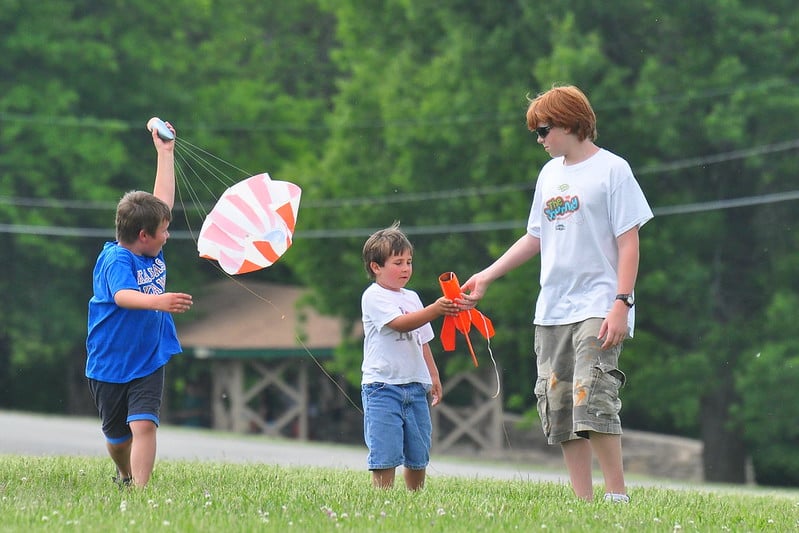Rockets have captured the imagination of people for a long time, and while building a crewed craft that goes to space may be unrealistic for most of us, there are still heaps of rocket projects we can build, fly, and learn from.
Model rocketry is a popular pastime and a great entry point for those curious about rockets. A good place to start is with a basic kit and launch system. Of the many model rocket kit manufacturers, the “Estes” company is perhaps the most well-known, available, and affordable. The Estes Tandem starter kit, which includes 2 model rockets and some launch equipment, retails for around $40. But let’s backpedal and see how these model rockets work.
Packed for Power
Basically, they use solid rocket propellant in a motor. The motor is a stiff cardboard tube plugged on one end with a clay nozzle that has a small hole through it. Above the nozzle inside the motor is black powder packed in such a way that it burns and pushes gas out through the nozzle. (A word of caution: don’t ever cut open or try to dissemble a motor.) When the motor is held in the rocket “airframe” (the collection of tubes, nosecones, and fins) the pushed-out gas provides the force to move the rocket upwards quickly.
Solid Rocket Propellant (SRP) is one type of rocket motor that large commercial space flights use. Other systems include bipropellant engines that mix fuel and an oxidizer.
Now back to the model. The launch is initiated when an igniter (a special electrical match) is connected to the launch controller and multiple buttons on the controller are pressed. The rocket motor burns and the rocket flies upwards. When the motor runs out, the rocket will continue upward under its own momentum until it reaches the extent of its energy or “top of its flight”, often referred to as apogee. It then falls back toward the ground. Obviously, we want to prevent this as it will smash on impact, and could get a little dangerous.
Fortunately, the small model rocket motors have a system by which, after they have burnt out, a small internal fuse burns for a certain amount of “delay” time. After the allotted time, the fuse burns into a loosely packed charge inside the top of the motor, which then blows through a thin clay plug and ejects a big puff of gas into the model rocket. This “ejection charge” pushes off the rocket’s nose cone and then pushes out a parachute that has been carefully folded and attached inside the rocket. Hopefully, your rocket will now descend back down to earth safely, ready to repack, reload, and fly again.
Rocket Tips & Types
Rocket motors for model rockets are sold separately and use a special system of diameter letters and numbers to identify different types. Model rocket motors come in a few specific diameters, notably 13mm, 18mm, and 24mm. Your model will come with instructions that tell you which motor size and power your rocket can safely fly with.
For example, a good motor choice for the rockets in the aforementioned Estes Tandem kit is the B6-4. The letter B indicates a power or impulse range that the motor sits in. “A” impulse is the smallest and least powerful; “B” is more powerful than “A”; and this continues up to “G” impulse. In most parts of the world, D through G power ranges are considered “Mid-power Rocketry”. Beyond G class puts you in the realm of High Power Rocketry. For that, you would need to be a member of a high-power rocketry club, have insurance, and pass accredited flights to be able to purchase and fly H class and above motors.
While high-power rocketry is a fantastic hobby, there is plenty to learn with mid-power rocketry. In fact, people have flown extremely high-altitude rockets and even broken the sound barrier with model rockets.
When starting with model rocketry it’s worth thinking about where you might fly your rockets. If you are lucky enough to be close to a rocketry club then it’s highly recommended that you join and attend local flying days where experienced model rocket enthusiasts are there to safely set up the site and equipment. If you aren’t near a club, research the minimum dimensions needed for flying your rocket safely. Obviously, this varies with the power and performance of different rockets, but a field around the size of a full football pitch that is not near buildings is about the right size for beginner A- and B-class rockets. If you live in a rural spot perhaps asking a local farmer or landowner with a large piece of property might be a good option.
Once you have mastered a few standard model flights, you might enjoy researching what other rocketeers from around the world are building and flying. Lots of rocketry clubs have websites where members’ builds and flights are documented. Some prefer scale modeling where they try to make accurate models of real full-size rockets; some prefer sport flying; trying to get a rocket to go as high as possible or stay aloft under a parachute for the longest duration. People like to make strange-shaped rockets or build rockets that go faster than the speed of sound.
Whether you end up making your own radical designs, or you simply enjoy building and flying kits, it’s a satisfying and fun hobby with a great community around the world.
learn more
Amateur Rocketry
https://www.simplify3d.com/resources/materials-guide/
Amateur Rocket Certification
https://www.faa.gov/space/licenses/amateur-rockets
Basic Model Rocketry
https://brshobbies.com/rocketry-101/
Best Model Rocket Kits in 2023
Record-breaking Amateur Rocket Flight
https://www.space.com/record-breaking-amateur-rocket-flight-higher-mount-everest
History of Rockets
https://www.grc.nasa.gov/www/k-12/TRC/Rockets/history_of_rockets.html
A Brief History of Model Rockets
https://rocketeers.in/the-rise-and-rise-of-model-rocketry-a-brief-history-of-model-rockets/
Rocket Motor Basics
https://www.apogeerockets.com/Rocket-Motor-Basics-Quick-Start-Guide
Model Rocket Engine Sizes and Classifications
https://themodelrocket.com/model-rocket-engine-sizes-and-classifications/
5 Best Estes Model Rocket Kits
Model Rockets
https://whyy.pbslearningmedia.org/resource/a0897693-cded-42ce-8d59-c17acb591faf/model-rockets/
NAR Model Rocket Safety Code
https://www.nar.org/safety-information/model-rocket-safety-code/
Model Rocket Safety
https://www1.grc.nasa.gov/beginners-guide-to-aeronautics/model-rocket-safety/
Parachutes
https://www.nar.org/educational-resources/model-rocket-building-techniques/parachutes/
How to Fold a Parachute
https://www.youtube.com/watch?v=N5l_SST5t8M
Veterans Soar with Model Rockets
https://www.va.gov/providence-health-care/stories/veterans-soaring-with-model-rockets/
School Kids Build Model Rockets
https://www.youtube.com/watch?v=9bEMTdiCATk
Inspiring Rockets
https://www.museumofflight.org/exhibits-and-events/exhibits/inspiring-rockets

